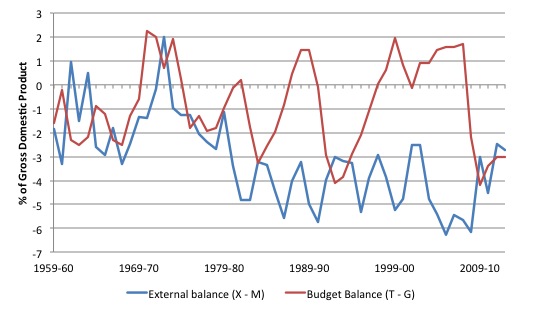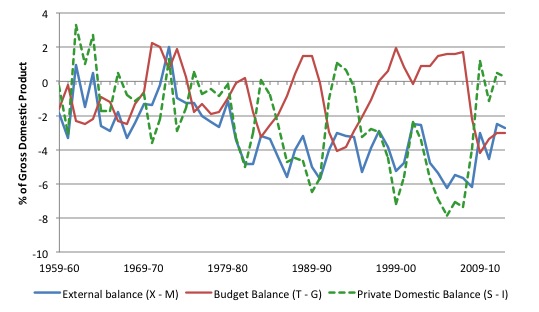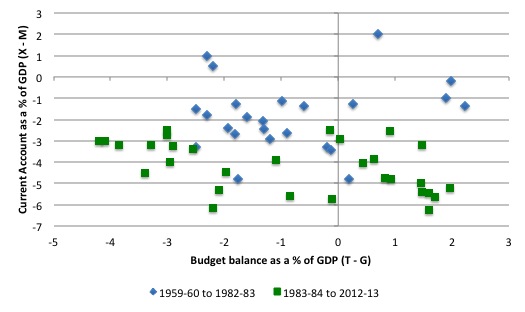It’s Wednesday and I just finished a ‘Conversation’ with the Economics Society of Australia, where I talked about Modern Monetary Theory (MMT) and its application to current policy issues. Some of the questions were excellent and challenging to answer, which is the best way. You can view an edited version of the discussion below and…
Twin Deficits and Sustainability Of Budget Deficits – Part 2
I am now using Friday’s blog space to provide draft versions of the Modern Monetary Theory textbook that I am writing with my colleague and friend Randy Wray. We expect to publish the text sometime early in 2014. Comments are always welcome. Remember this is a textbook aimed at undergraduate students and so the writing will be different from my usual blog free-for-all. Note also that the text I post is just the work I am doing by way of the first draft so the material posted will not represent the complete text. Further it will change once the two of us have edited it.
Today continues the material that appeared in:
Chapter 25 Recent Policy Debates
In this Chapter we consider the following policy debates:
- 25.1: Ageing, Social Security, and the Intergenerational Debate
- 25.2: Twin Deficits and Sustainability Of Budget Deficits
- 25.3: Fixed Versus Flexible Exchange Rates: Optimal Currency Areas, the Bancor, or Floating Rates?
- 25.4: Economic Growth: Demand or Supply Constrained?
- 25.5: Environmental Sustainability and Economic Growth
25.2 The twin deficits hypothesis
[EARLIER MATERIAL]
We can re-arrange Equation (25.1) to express it more directly in the twin deficits hypothesis form:
(25.2) (X – M) = (S – I) + (T – G)
Note that we are now expressing the budget balance as (T – G) with the interpretation that if T > G, then there is a budget surplus.
The Twin Deficits Hypothesis imputes a strict causality between the sectoral flows where the private sector savings and investment gap is zero or stable, and changes in the budget deficit translate directly into current account deficit.
This construction is used to justify the claims noted at the outset that a current account deficit represents a nation “spending more than it is earning” and this imbalance is caused by budget deficits which leads to increasing external debt.
Accordingly, the risk of foreign financial market retribution via downgrading by international ratings agencies and the like is related to rising budget deficits. The cure for a chronic current account deficit then is logically to be found in increased domestic savings emanating from budget surpluses.
[NEW MATERIAL STARTS HERE]
The problem is that the causality is not guaranteed. If there is variation in the private domestic balance then the strict link between the current account and the budget balances will not be observed. The evidence from many nations is that the private domestic balance is far from stable over time.
In other words, if, for example the budget was to be balanced (for the sake of argument) over time, and private households and firms started spending more than their income (that is S – I < 0), then that deficit has to be funded by the foreign savings and the current account balance would move into deficit of an equivalent magnitude of GDP as was the private domestic deficit. The underlying economics that would be consistent with this observation might be that increased spending by households on consumption imports and/or spending by firms on investment imports (capital equipment) for a given state of world demand (which sets a nation's export performance) will produce a trade deficit. Foreign savers will be prepared to fund this deficit because they are willing to accumulate net financial claims in the currency of the deficit nation in return for shipping more real goods and services to the nation that it exports abroad. The opposite would be the situation if there was a private domestic surplus. In other words, variations in the private domestic balance can drive fluctuations in the external balance quite apart from the state of the budget balance. Further, the current account position of a nation at any point in time can reflect international factors like imperfect competition, barriers to entry, economies of scale and general conditions of world trade, which are clearly beyond the control of the nation itself. All these factors may, for example, constrain the nation's export revenue. If, for example, there is a world recession, a trading economy with automatic stabilisers to experience a current account deficit as its export revenue collapses. The negative impact of the declining export revenue reduces the nation's aggregate demand which then leads to fall real GDP and national income growth. As a result, tax revenue for the national government will fall and the automatic stabilisers will push the budget into deficit or a higher deficit, depending on the position of the budget balance prior to the shift in real GDP growth. In other words, the causality is reversed. Changes in the external sector beyond a nation's control create corresponding changes in the government's budget balance via the automatic stabilisers. In the previous example, a rising budget deficit may then act to support an increase in domestic income, which stimulates private domestic savings. The impact on the private domestic balance can then feedback on changes in the external balance, with no explicit change in government policy. The other part of the Twin Deficits Hypothesis that we have considered in previous chapters is the claim that budget deficits drive up domestic interest rates because they draw on a finite pool of saving, which leads to increased competition for the scarce funds, which then leads to an appreciation in the nation's exchange rate which "crowds out" exports because the higher exchange rate renders the nation less internationally competitive. We have shown that budget deficits do not place upward pressure on interest rates. First, the interest rate is set by the central bank. Second, the claim that there is a finite pool of saving that budget deficits siphon (through debt-issuance) ignores the fact that the pool of saving grows as national income grows. This observation was a fundamental point of departure for Keynes from the Classical loanable funds doctrine (see Chapter 15). In other words, as we learned in Chapter 12, government spending (like any spending) brings forth its own saving via multiplied increases in national income. Third, banks are always willing to extend credit to customers who they think can meet the terms of the loan. We have learned that loans create deposits, and banks are not constrained by any prior reserve holdings (that is, savings) in their loan making activities. Case Study – Australia
Australia is a very open economy and exports and imports fluctuating around 20 per cent of GDP in real terms. Figure 24.2 shows the movement in the Federal budget deficit as a per cent of GDP (red line) and the Current Account deficit as a percent of GDP (blue line) for Australia for the financial years 1959-60 to 2012-13. From 1983 exchange rate was floated.
What would you conclude about the relationship between the current account balance and the budget balance from this real world evidence? Does it provide supporting evidence for the Twin Deficits Hypothesis?
Quite apart from causality issues, we would conclude from this data, that there has been no systematic relationship between the two balances for Australia as asserted by the Twin Deficits Hypothesis over this lengthy time period.
The Current Account continued to widen as the budget balance went into surplus in the late 1980s and from the mid-1990s. The fact that there is no systematic relationship, however, does not negate the fact that over certain periods, the movement in the external balance could be in response to shifts in the budget balance and vice versa. The mediating factor is the behaviour of the private domestic balance.
Figure 24.2 Current Account and Budget Balances, Australia, 1959-60 to 2012-13, per cent of GDP

Source: Australian Bureau of Statistics, Commonwealth of Australia Budget Paper No. 1. Note the budget balance is expressed as (T – G) so a deficit is a negative number.
Figure 24.3 shows the three sectoral balances for Australia for the financial years 1959-60 to 2012-13. It is clear that the private domestic balance is neither consistently zero or stable over time.
Figure 24.3 Sectoral Balances, Australia, 1959-60 to 2012-13, per cent of GDP

Source: Australian Bureau of Statistics, Commonwealth of Australia Budget Paper No. 1.
Figure 24.4 shows the budget balance for Australia on the horizontal axis and the current account balance on the horizontal for the period 1959-60 to 2012-13. The entire sample is split into the period prior to the formal float of the Australian dollar in 1983 (blue markers) and the period of floating exchange rates (green markers).
In neither period, is a well-defined relationship between the two balances suggested.
Figure 24.4 Current Account and Budget Balances, Australia, 1959-60 to 2012-13, per cent of GDP

Source: Reserve Bank of Australia, Australian Bureau of Statistics, Commonwealth of Australia Budget Paper No. 1.
Conclusion
NEXT WEEK – Fixed Versus Flexible Exchange Rates: Optimal Currency Areas, the Bancor, or Floating Rates?
Saturday Quiz
The Saturday Quiz will be back again tomorrow. It will be of an appropriate order of difficulty (-:
That is enough for today!
(c) Copyright 2013 Bill Mitchell. All Rights Reserved.
“Foreign savers will be prepared to fund this deficit because they are willing to accumulate net financial claims in the currency of the deficit nation in return for shipping more real goods and services to the nation that it exports abroad.”
Isn’t that particularly the case for nations where ‘exports are good’ is the prevailing dogma. By definition if the country is exporting more than it is importing, somebody is going to have to do liquidity swaps or the exporter will not be able to obtain their own currency in return for the goods shipped abroad.
“Foreign savers will be prepared to fund this deficit because they are willing to accumulate net financial claims in the currency of the deficit nation in return for shipping more real goods and services to the nation that it exports abroad.”
That also doesn’t cover cases like most latin-american (or african) countries, whose currencies have not much demand. I think, for example, nobody would be willing to hoard lots of the Argentina’s Pesos (in any form) nowadays. They must be net exporters? They should try to balance current account?
So, Neil and Bill respectfully, this is another chapter in the book? Bonds/gilts/treasuries etc. enter the picture here? What else – the layer of currency trading and arbitrage? Is this just pure rent creation left over from non floating currency regimens, or do we need any of this? Is it enough for nations to go to war, or do trade war. This seems to be the spectre hanging over us – dangled perhaps by beneficiaries to what I think might be a bunch of shenanigans.